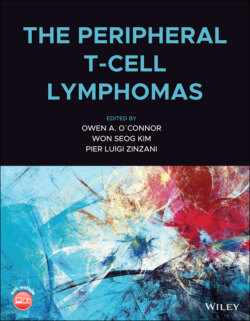Читать книгу The Peripheral T-Cell Lymphomas - Группа авторов - Страница 39
Chronic Antigenic Stimulation
ОглавлениеChronic antigen stimulation resulting in chronic B‐cell receptor or TCR activation, can promote lymphomagenesis. This concept is supported by the observation of biases in the B‐cell receptor repertoire in B‐cell malignancies, but most importantly the observation of response or cure after Helicobacter pylori or HCV eradication in some B‐cell malignancies, such as marginal zone lymphomas of splenic or mucosa‐associated lymphoid tissue types.
A similar model could be transposed to EATL. This primary intestinal lymphoma occurs as a rare but classical complication of celiac disease. Patients with celiac disease are intolerant to gluten, and uncomplicated lesions regress with gluten eviction. However, gluten intolerance translates to the development of refractory sprue, ulcerative jejunal lesions and ultimately EATL, characterized by a clonal expansion of aberrant intraepithelial lymphocytes, with aggressive features and poor prognosis. Genetic alterations are found in these lymphomas, especially affecting the JAK–STAT pathway [54], and correlation between EATL occurrence and poor observance of a gluten‐free diet in patients with celiac disease suggests the role of the chronic antigenic stimulation induced by gluten [103].
More recently, increasing numbers of ALCL developing at the contact of textured breast implants have been reported. The disease presents most often with neoplastic T cells restricted to the seroma and/or the surface of the periprosthetic capsule (“in‐situ form”), and more rarely as a tumor mass within the capsule and the adjacent tissues (“infiltrative form”). While the infiltrative form of the disease can have an aggressive course and requires systemic chemotherapy, the in‐situ form usually regresses after capsulectomy. A model of lymphomagenesis induced by local inflammation and chronic antigenic stimulation is proposed. The resulting high levels of cytokines in the periprosthetic confined milieu could favor the expansion of cytotoxic cells, which would subsequently acquire somatic mutations. Several studies have identified recurrent mutations in epigenetic modifiers (KMT2C, KMT2D, CHD2, CREBBP) and JAK–STAT signaling (STAT3, JAK1, STAT5B) pathway) [28, 104]. The role of a bacteria, Ralstonia pickettii, in promoting inflammation, has been suspected, although this remains controversial [105].
